Can you swim? Swimming is by no means a natural human activity, which is why at least 4 billion people in the world cannot swim. So if you can’t swim, Triathlon inevitable become a hurdle for you.
That’s why Duathlon becomes another popular sport after the Triathlon. Duathlon is a two-sport race that involves running and cycling in three stages (run-bike-run).
Duathlon is good for those who want to try to get into multi-sport race, but it may not be easy with an open water swim, or for triathletes who can’t get in the open water during the seasons.
What to wear for Duathlon?
During the race day, be sure to check the weather to dress yourself accordingly. If it is warm, then shorts and a shirt will do. If it is chilly, perhaps a jacket, long fingered gloves, or even tights might be required.
Running shorts is great for running, because there are no padding for the bike (a fearful thought to some), and blow about in the wind, thus slowing you down on the bike.
On the other hand, bike shorts are more aerodynamic and the padding is certainly a blessing when you might be on the bike for an hour or more.
However, if you run in a pair of bike shorts, the feeling of wearing it, is like a toddler walking around with a diaper on. These shorts are similar to a bike short, except one with slightly shorter legs, and a thinner pad that will not bother you when you are running.
For upper wear, the preference would be like Jogbra, a tank top, or a shirt. A short sleeved or sleeveless bike jersey also do works best, and the zippered front will allow to cool down if the temperatures rise before the second run.
How to train for Duathlon for beginners?
Here are some tips for beginners to train for a Duathlon.
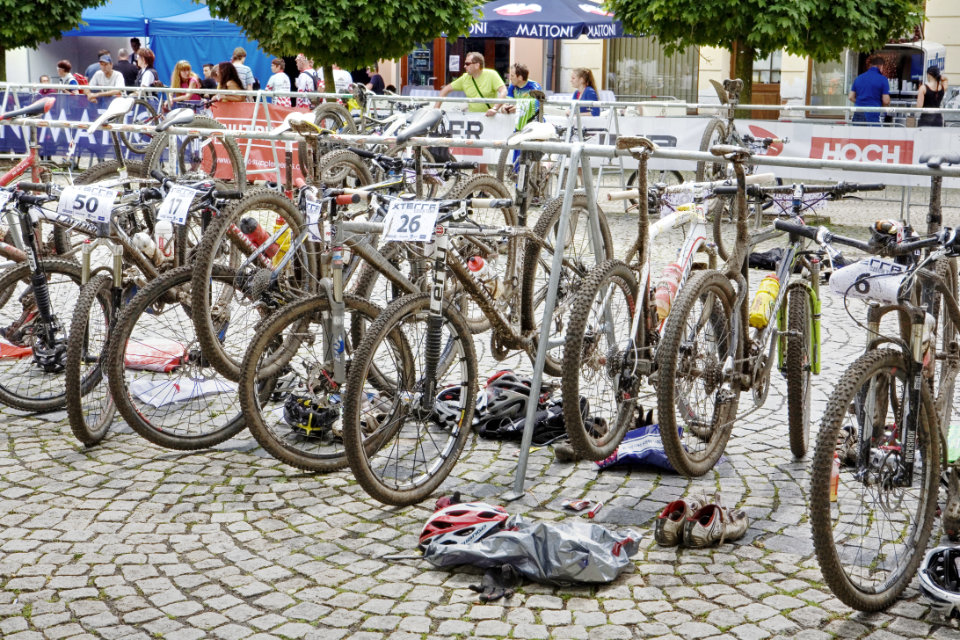
Running Session
Endurance
You can start with a light jog, three sets (minimum). 1 mile or 2 mile attempts with 90 seconds of rest. If your body is used to it, you could work towards five or six sets.
Speed session
400m or 800m reps, between 10 and 15 sets. With a 2 min light jog, it allows the muscles stay warm to avoid the build-up of lactic acid.
Bike Session
If you have access to a gym that has a spin bike it would be a good idea to bike indoors. It can provide an effective training session, with a cadence, which indicates the amount of power you push through the pedals.
It would be ideal to have a cadence of 80 if you choose to use this approach to do your sessions. This is the pace, which you would want to race. The lower the cadence, the more energy you need to push through the pedals.
Endurance
4 min reps of 10. Each minute, you can increase the resistance (go up the gear), so you’re working on a slow climb of the hill, helping you to develop stamina and power. It’s good to take at least 2 minutes to recover the light spin on an easy gear.
Hill climb
5 min reps of 8 sets again. This can be altered to the amount you feel able to do. You want to be pushing a cadence of 50 for a hill climb. This can be done seated or standing, but you will build more strength doing a seated climb.
Combining the two disciplines together
Lastly, you must combine both disciplines into one session, so that your body can adapt to the quick changeover. Some people will practise, so that they can save time during the race. 1 km of runs followed by a 10 min loop and then 1 km of runs.
You can run and cycle for as long as you feel like you’re doing it. You can do a light jog or spin to recover for 2-3 minutes. This can be done in a set of 4 to 8.
A bike and run combined session is a must in your training, so it would allow the muscles to adapt. You could do an interval training, like 2 minutes run followed by 5 minute ride. It would be best to do it in a shorter sessions fast with more sets.
Duathlon tips for beginners
Preparation is key
Do research on Duathlon, and get the knowledge on how to train for the Duathlon. Do not rush to get into training by not having the knowledge of it.
You can seek advice from the Duathlon community, they will be willing to share their experience, and tips and tricks about Duathlon. Hire a Duathlon coach it is a good option as well. So that he or she knows how to plan out your training plan for the Duathlon.
Don’t focus on speed first
It is important not to rush on completing the training session. Complete the distance, and after each exercise, aim to save a little reserve. This will help you finish all the training sessions without feeling too exhausted.
Range of training
The exercises in this program were designed to help you navigate your first step into the Duathlon sport. You should have been trained to complete all the required workouts.
If you have time and energy to do more than is assigned to this plan, then you’re going to be ready for the race. Just remember rest days should be a rest day. Do not to add anything extra, keep them free to stretch and let your body recover.
Substitution of workouts
If you’re going to have to tweak the exercises in this plan, there’s no trouble switching days. Life circumstances, weather equipment, etc. can determine what you can do and when. Just remember to let your body rest and recovery, if not your body will be overly fatigued.
Cycling techniques
A part of the cycling workout may be done by static machines or exercise bikes. A spin class at a fitness center or a stationary bike is a good substitute if you can’t ride outdoors.
But you have to train to be comfortable riding your bike on the streets. Before the day of the run for about a few weeks, it is extremely important that you can push, steer and brake properly.
If you’re new to road biking, just use a comfortable bicycle like a commuter, a hybrid or a mountain bike.
No one’s going to judge on your wheel. Make sure you’re in a position to be able to steer, ride straight, split, and use your gear. Also, you’ve calibrated it well in advance of the race if things don’t seem to work properly.
Running techniques
Keep in mind that you can walk as needed during the Duathlon. If you are a beginner runner or are carrying extra weight, it is recommended to use the Fun Run approach to alternate between jogging and walking as a strategy to build stamina.
Don’t rush the pace, just try to keep jogging for a couple of minutes and then take a walk break when you need to.
Things you should know about Duathlon
Don’t start too hard
All too often, however, they spend the rest of the run paying for it and end up being slower overall as a result.
To duathletes, the start will evoke memories of school running competitions all over again, and the excitement can make you better off. So, don’t rush and start calmly.
Measure out your effort to finish strongly and leave the glory chasers to fade later in the race.
Practise your transitions repeatedly
It is important to practise your transitions, to make sure you are used to it. You can start with a warm up, then repeat running in, changing shoes, putting your helmet on and running out to mount your bike. Each time you exit or enter hit the lap timer on your stopwatch or have someone to time for you.
All you need to do is ride or run gently for a short distance back and forth and, as you do, think about what went well and what didn’t happen in the last transition, and then aim to keep going faster and faster in the transition during the session.
Get two pairs of trainers
So cut even more of the transition times, a Duathlon trick is to use a different pair of shoes for each race.
This way, the second pair will be available and perfectly positioned in turn to slide on rather than cast off where they were left after the first sprint, as often happens with just one pair.
After getting soaked in the knowledge about Duathlon, these six duathletes are the encouragement you will need to prepare your upcoming Duathlon race.
Training Tips From 6 Top Duathletes
1. Allison, Yee Phui Se
Bio: 23 year-old Malaysian, Student/Athlete/Entrepreneur
Allison is a full time student who is currently a final year student, studying the Bachelors of Wood Science and Technology in UPM. She picked up running as a leisure sport 5 years ago and progressed into competitive road races and multi sports 3 years ago. Back then, she learned swimming and cycling from zero.

Do what you love and love what you do matters.
RS: Duathlon is a challenging sport. What makes you go for Duathlon consistently?
Allison: Yes indeed. As cycling and running are better than my swim, I will race my best disciplines and work my weakest discipline (swimming) at the same time.
RS: Duathlon requires strong legs to keep going during the competition. What are your best tips to avoid knee injuries during training and competition?
Allison: Many of the athletes neglected the importance of strength training regularly throughout their training regime. Stronger muscles keep your performance on top and joints healthy. Endurance sports will tend to make your muscles break down if you didn’t maintain your muscles.
RS: How do you plan and train for your Duathlon?
Allison: My coach will plan the program for me through training peaks. Typically, it will be two seasons. In a week, I will have 2 times of strength trainings, 3 to 4 times of training sessions, 1 to 2 track workouts, 1 to 2 swims, 1 long ride , 1 long run, a few times of simulations (brick workout with teammates). The program will change and progressed as it gets closer to the race day.
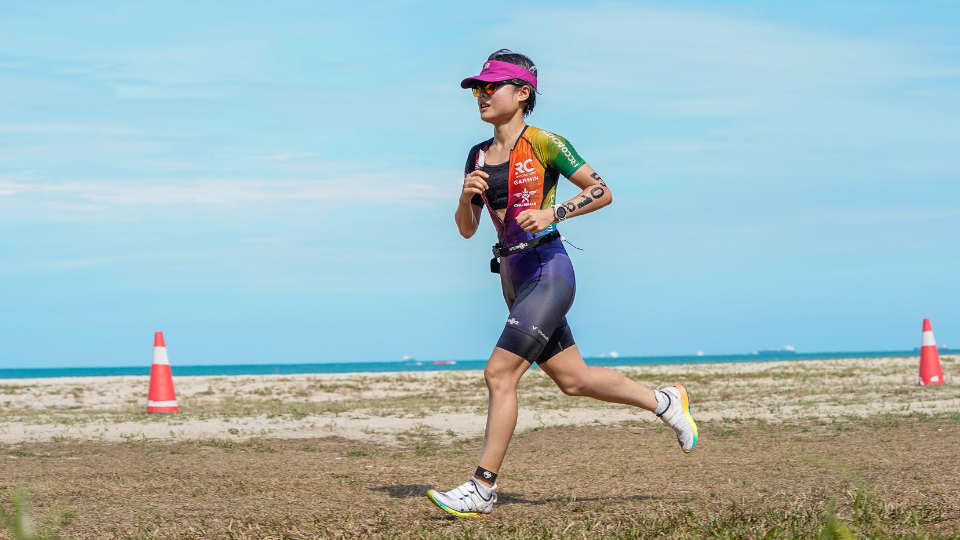
RS: What is your go-to meal or snacks before your Duathlon competition?
Allison: Most of the time, I cook my own meals. Usually, breakfast I will have eggs, toast, coffee and avocado. Mostly lunch, I will have rice and dishes. I will opt for more vegetable and beans or lean meat (chicken breast).
In between training and meals, I will have a recovery drink mix to bridge the gap for maximum recovery. Dinner is not fixed, because I might be having meals with my teammates and friends.
Before a race, I will have a typical breakfast, but consist more carbohydrates in ratio. Before the flag off, I will have an additional gel to get the sugar rush to get ready for the race.
RS: How do you handle your stress and pressure during your Duathlon competition?
Allison: Positive mindset and be patient, trust in your training and coach. Eliminate stress and pressure if you can because it is unnecessary. Manage what you can and trust in it.
RS: What is the key to become a successful Duathlete?
Allison: The key is to be consistent, be humble, trust your progress and yourself. Talk to anyone or your coach if you need to, because it will clear your doubt and give you a new perspective.
Success comes differently from everybody. Different person has a different spectrum of success. Just give your 100% commitment in what you do. Do what you love and love what you do matters.
RS: Are there some useful tips and tricks for beginners who want to do Duathlon?
Allison: Base building is the main part. Do not rush into breaking PBs, buying new and higher range of gears for race/training without having a proper bike handling skills or race experience.
I’d suggest slowly building up your volume in months and work more on basic and nutrition (what you eat) leading up to your “A” race.
Most of the beginners got too excited and signed up too many big and small races, while they are training for a major race and injured themselves in between. Just be patient and learn along the way. Enjoy the process!
You can follow Allison on Instagram: @allison_phuise
2. Jason Loh Chwan Chyin
Bio: 27 year-old Malaysian, Data Centre Engineer
Born in Muar, Johor and raised in Kuala Lumpur, Jason is the middle child among his 3 siblings. He graduated from Multimedia University and studied Electronic Engineering majoring in Telecommunications. Jason works full time as a Data Centre Engineer.
He started track and field since 13 year-old. He is also a Selangor state representative in Long Jump, and district representative in Cross Country when he is 16-17 years old. He started Duathlon in 2012 and Triathlon in 2014. Last but not least, he is a national representative in the Asian Beach Games in 2014 and SEA Games 2019.
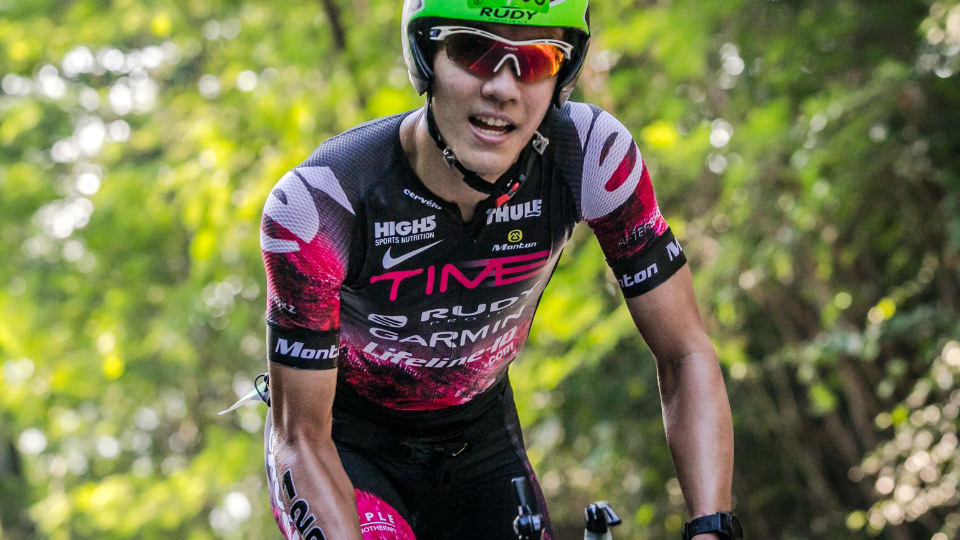
Disciplined attitude and resilient mindset is a way to be a successful Duathlete.
RS: Duathlon is a challenging sport. What makes you go for Duathlon consistently?
Jason: I have been running for about 12 years now, started from track and field to long distance running. During my university days, I wanted to try and explore something new and challenging on top of just running itself, therefore Duathlon would be the closest option to go for.
I realised that the combination of these two disciplines makes the race format even more exciting and interesting. As a competitive athlete, one always wants to achieve greater heights after achieving a certain milestone.
One milestone after another, I am aiming for something greater and higher, which kept me motivated and pushes me to drive further to excellence. For a beginner since 2012 until today, I will be representing the country in the upcoming SEA Games 2019 in the Philippines.
RS: What are your best tips to avoid injuries during training and competition?
Jason: These are a few tips to prevent injuries:
- Proper running technique – Emphasise on doing running drills regularly before run to improve running form.
- Strength workout in the training plan – Strengthen muscles around the legs to allow better shock absorption.
- Proper footwear – Choose a suitable shoe type for specific run session (ex. volume/cushioned trainers for long runs), and replace the shoe when the lifespan is up.
- Proper training load across a prioritisation plan – Mileages differ across micro and macro-cycle of a block of the training plan. Build a good base first, then increase mileage and intensity accordingly, and taper well before the race.
- Supplement – Additional supplement may be required for certain groups of people to improve fast recovery and keep the joints healthy.
RS: How do you plan and train for your Duathlon?
Jason: Training plan:
- Monday: Run/bike trainer/gym session and swim session
- Tuesday: Track session
- Wednesday: Swim session
- Thursday: Cycle to workplace and back home, run session
- Friday: Swimming session
- Saturday: Long run/brick session and easy spin
- Sunday: Long ride and light run
In general, training per week consists of 3 swim, 3-4 run, 4-5 cycling, 1-2 gym sessions.
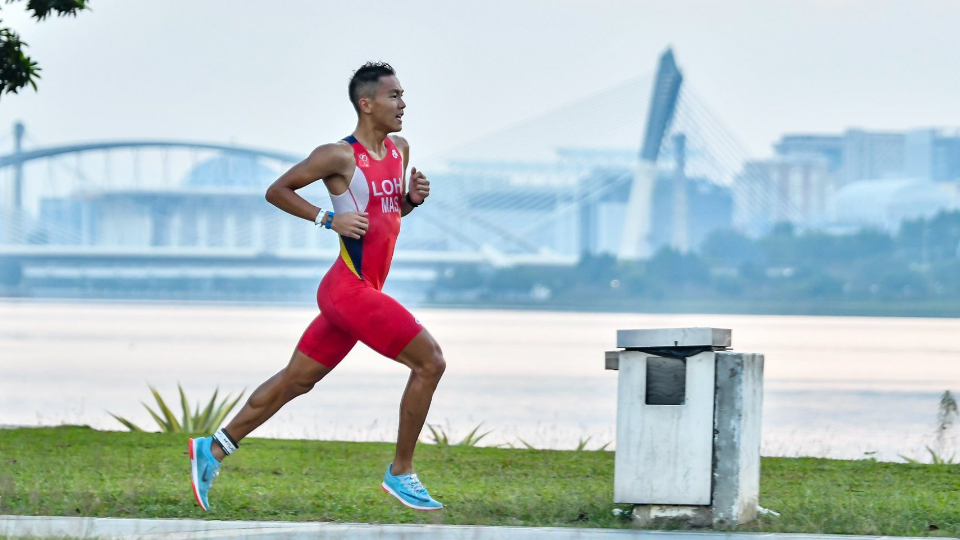
RS: What is your go-to meal or snacks before your Duathlon competition?
Jason: Less than 12 hours before the race, I will have a protein bar, more than 12 hours before the race, I will not have snacks, just good carbs intake.
RS: How do you handle your stress and pressure during your Duathlon competition?
Jason: Focus on the mind, strategy and race rhythm.
RS: What is the key to become a successful Duathlete?
Jason: Disciplined attitude and resilient mindset.
RS: Are there some useful tips and tricks for beginners who want to do Duathlon?
Jason: Here are the tips and tricks:
- Get a coach/training plan to start with.
- Get to know and train with Duathlon/Triathlon community/clubs.
- Get an entry level/decent bike, proper cycling attire, necessary bike tools and accessories to start with.
- Sign up for short distance events to start with.
- Log and monitor your progress and work on the weakness. Last but not least, keep training!
You can follow Jason on Instagram: @jasonloh23
3. Samh Jain
Bio: 15 years-old Indian, Student
Samh Jain is a student and a promising multi-sport athlete who resides in Singapore with his family.
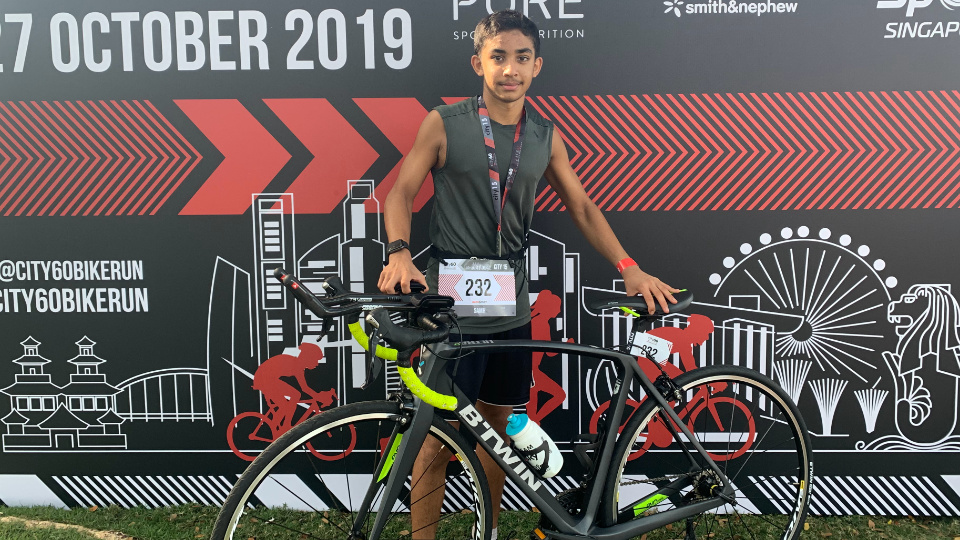
Duathlon is a sport that challenges you both physically and mentally and that is the one of the reasons I enjoy it.
RS: How do you get started with Duathlon?
Samh Jain: I like to participate in Duathlon at first, because it is a lot of fun. If you decide to participate in one, go enjoy and have fun; that’s the priority. Secondly, it’s a sport that challenges you both physically and mentally and that is the one of the reasons I enjoy it and push myself harder and harder.
RS: What are your best tips to avoid injuries during training and competition?
Samh Jain: If you are just beginning, slowly ramps up your training from the bike/run. I personally had some knee issues sometimes, but it’s best to keep away from the bike/run training at those times and instead target the upper body. I also definitely recommend rolling, and stretching every night.
Before every training session for a Duathlon, it will take quite a toll on your legs, building muscle and very regularly, the muscles will be very tight and may cause pain if you push too far without rolling/stretching.
RS: How do you plan and train for your duathlon?
Samh Jain: The main thing here is you need to run and ride regularly, which I assume is a given. Starting off a Duathlon is a run, followed by a transition onto the bike.
You need to practice this sometimes, slipping on bike shoes (if applicable) and especially mounting onto your bike if you are looking to cut down time and crack a new PB.
Something that you can pop into your training regime is a brick session, where you ride followed immediately by a run.
This will not feel good, but this is how you will feel during the second transition in a Duathlon. You need to remember that you will never feel poppy coming off from the bike, and you will feel the sensation of heavy legs after biking for some distance at speed.
Doing brick sessions regularly will make you more confident on this last leg, which is usually the most crucial leg and where athletes can lose their lead from the bike.
I run quite often using a planned program, and you need to incorporate easy runs, speed work, intervals, and long runs into your program, but remember that an easy run has to be easy. It may feel like you are not improving, however, by doing this you are building your aerobic capacity.
For biking, I ride regularly during the season, in the morning, and one can include threshold rides, intervals, over-gearing, and easy long runs into their ride program.
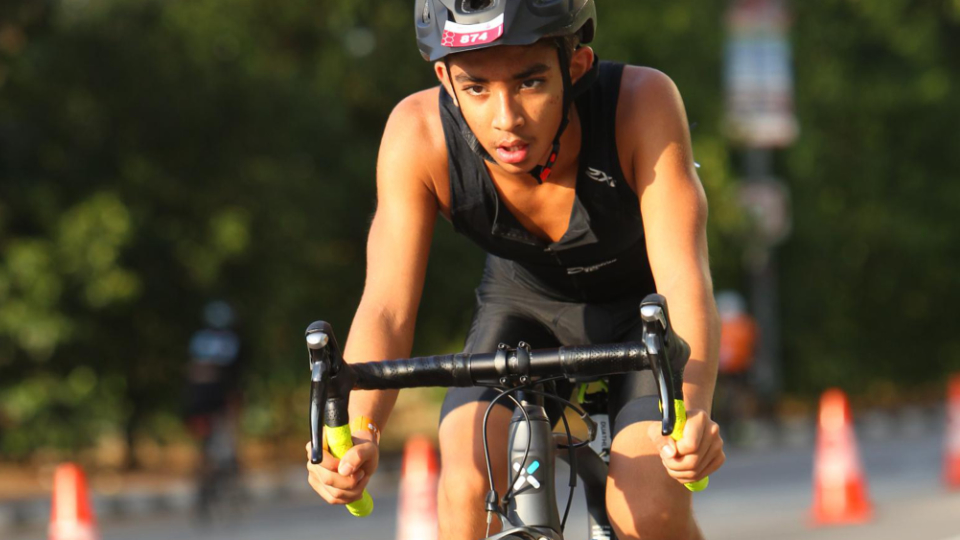
RS: What is your go-to meal or snacks before your Duathlon competition?
Samh Jain: Banana and protein bars, I’m all about them, however, you should make sure you have some sort of nutrient and energy-filled breakfast on race day.
If you are serious about racing, I suggest Carbo loading a few days before the Duathlon, as you need to exert lots energy, so those built-up carbohydrate stores will come in handy.
RS: How do you handle your stress and pressure during your Duathlon competition?
Samh Jain: Relax and enjoy the race venue. Also, visualize yourself crossing that finish line. You should know yourself, that you are prepared and you have everything in transition ready.
RS: What do you think is the key to becoming a successful Duathlete?
Samh Jain: Regular training, even if that’s not bike/running being in the gym regularly, or doing other sports. Race experience is also quite a key, and the more races you do, the easier and familiar it will get.
RS: Are there some useful tips and tricks for beginners who want to do Duathlon?
Samh Jain: Most importantly, you need to remember to enjoy the race and have fun. Some tricks can include making sure you’ve done that race distance in training, so it’s not a surprise.
On the race day, have a look at the map and make sure you’ve studied and know the course beforehand. Make sure to have a fast transition and to save some energy in the tank for the last run leg, remember it will not feel good at the start.
You can follow Samh on Instagram: @sammyboy_rofl
4. Mariana Binti Mohammad
Bio: 41 year-old Malaysian Full-time housewife
Mariana is from Land Below The Wind, Sabah. She was born in Lahad Datu, Sabah. Mariana grew up and went to school in Kota Kinabalu, Sabah and is now residing in Cyberjaya, Selangor.
She is married to an Australian and have 2 children, a 18 year-old and a 16 year-old girl. She is a full-time housewife and her husband is the breadwinner. She like running and cycling, hence, Duathlon is her favourite sport.
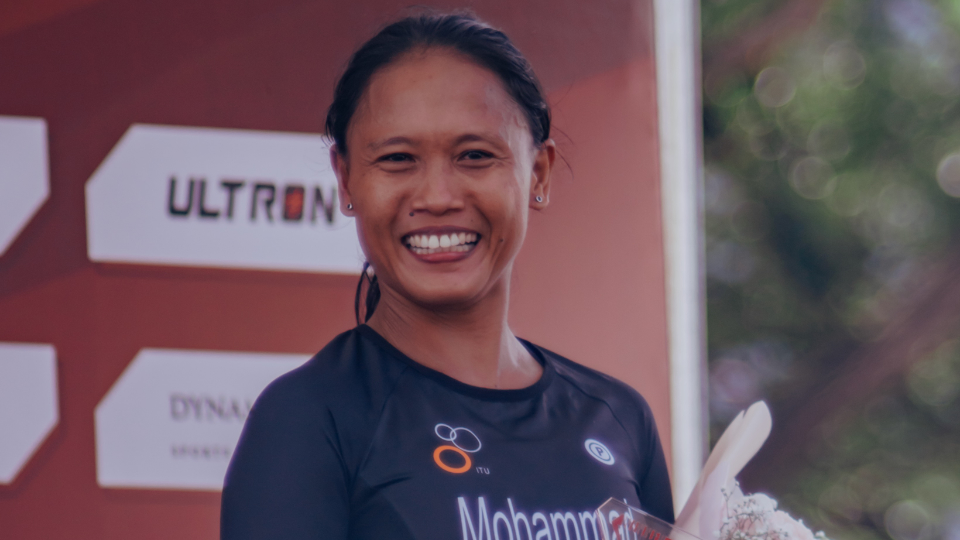
Prepare well, pace yourself well, save time on transitions, race your best and always stay positive!
RS: How do you get started with Duathlon?
Mariana: Yes, Duathlon is a very challenging sport as it legs based sports. You run, you bike, then you run again. I consistently do Duathlon cause its the only sport that fits me best as I like running and cycling and I like the challenge that this sport has to offer.
RS: What are your best tips to avoid injuries during training and competition?
Mariana: Doing Duathlon you prone to getting knee injuries. My best tip would be equipped yourself with good running shoes that suits your feet. You should have a few pairs for training and competition.
Maintenance is very important. After running or cycling, should do stretching. Legs recovery is vital. Go for a massage, ice bath or Physio to make sure legs are always ready for the next training session or competition.
RS: How do you plan and train for your duathlon?
Mariana: My training plan is a 4 week training plan. I will have my building phase right through to the specific training. As a seasoned athlete, I already have a good base of running and cycling.
Generally, the first 3 weeks will be training with some high intensities included some brick sessions. The 4th week, will be a recovery week with less intense training.
Example of my training plan for a week :
- Monday : Rest day
- Tuesday morning : Cycling in 4 hours in moderate
Tuesday evening : Run in 1 hour in moderate - Wednesday morning : Running intervals in hard level
Wednesday evening : Cycling for 1 hour in easy level - Thursday morning : Cycling for 2 hours with some effort in hard level
Thursday evening : Running for 1 hour in easy level - Friday : Gym session, Strength and Conditioning
- Saturday : Long distance run for 2 hours in moderate
- Sunday : Brick session, Run for 1 hour, Cycling for 3 hours, followed by run after in moderate
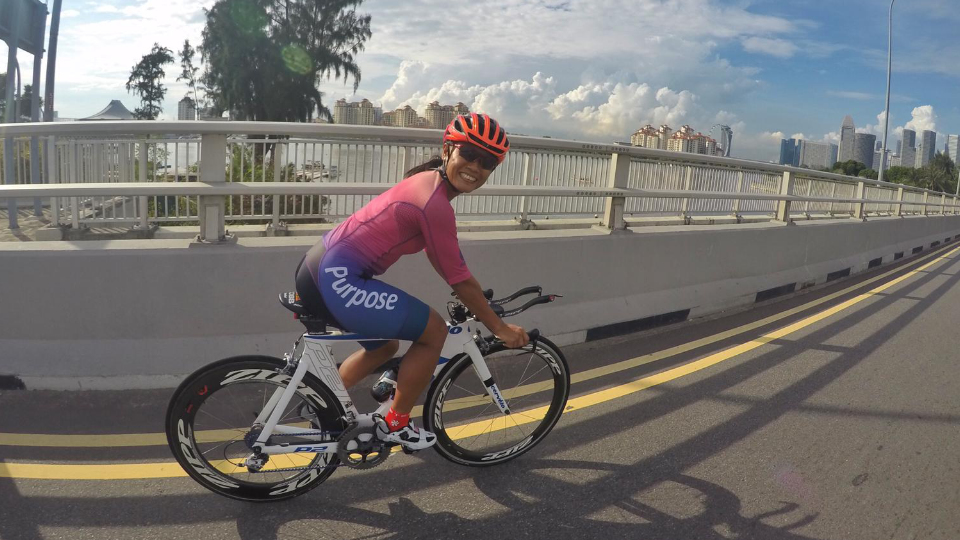
RS: What is your go-to meal or snacks before your Duathlon competition?
Mariana: I’m sponsored by Hutan Ration Powerfood. The bars are made from 100% real high energy ingredients and it’s very filling. Usually, I will have one of the bars 45 – 30 minutes prior to games and I was all ready for the race.
RS: How do you handle your stress and pressure during your Duathlon competition?
Mariana: Before the race starts, I will take a few deep breaths. I do self talk to calm myself. Once the competitions started, I just race my best.
RS: What is the key to become a successful Duathlete?
Mariana: Committed and consistency! Never give up!
RS: Are there some useful tips and tricks for beginners who want to do Duathlon?
Mariana: Prepare well, pace yourself well, save your time on transitions, race your best and always stay positive!
You can follow Mariana on Instagram: @marianaford
5. Eileen Loo
Bio: 40 year-old Singaporean, Manager
Everyone has their story to share. Eileen got into running first, then Duathlon. She was inspired by her colleagues 8 years ago to start running.
Her senior manager, vice presidents and CEO were running half and full marathons, however, she was smoking and can’t run a 2.5km. She felt breathless, pathetic being half their age. They inspired Eileen with their age and health that was full of vigour.
That was her turning point to start running. Eileen started to walk-run 2.5km and slowly built to 10km and 21km distance in 2-3 years. It’s wasn’t an overnight sensation to beat anyone nor a quick fix 3 month regime to 21km. The motivation was intrinsic, and she realised that is the key to continue running as a lifestyle and not an exercise task.
She felt blessed in Singapore with sunny weather and be able to participate in all types of run, cycle and multi-sports races. OCBC cycling was the first cycling race that challenges her mindset that she don’t need a fancy bike or be a pro-cyclist to participate in races.
Every new race is a challenge for Eileen to overcome. That’s how she starts participating in Duathlons and Triathlon races.
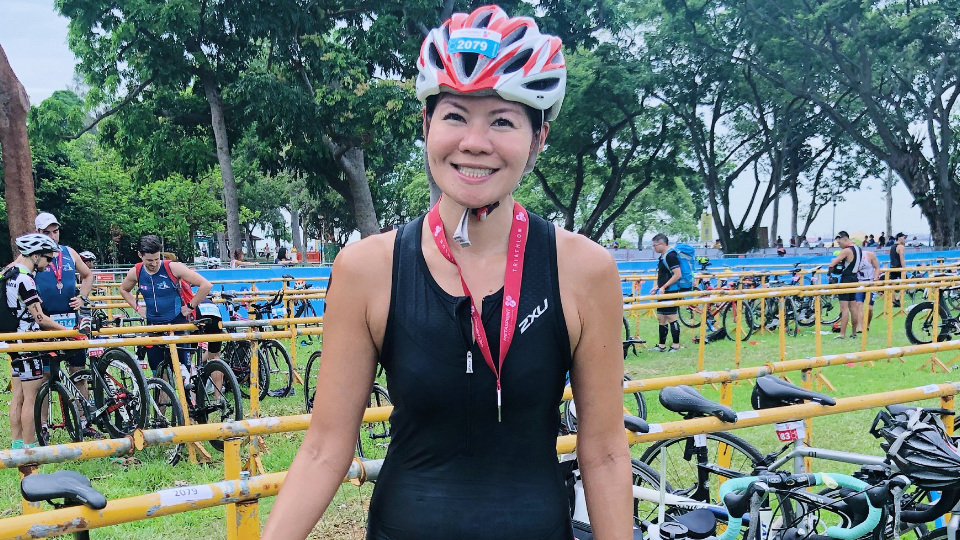
The only stress and pressure you have are the ones you put on yourself. So, trust what you have been training for.
RS: What makes you go for Duathlon?
Eileen: I find Duathlon helpful to build one’s mental strength and endurance. It adds variety vs a single run race. Adding another sport like cycling makes it more exciting for my mind during training.
Seriously, it’s easier on the joints mixing both run and cycle discipline. I always have buyer remorse when I sign up for Duathlon or new multi-sports races. Why did I do this to myself? Worse on race day with thoughts like: “Eileen, shouldn’t you be sleeping on a Sunday at 5 am, competing for not 1 but 2 races!?”
Despite it all, no one can take away that experience from you when you cross the finishing line. My driving motivation is to sign-up deadlines or new races afraid. That’s the life I want to live. Constantly pushing my mental strength and endurance.
We race at our own pace. Plus, I get to meet supportive, like-minded folks in these multi-sport races and is now a community sport less of a race.
RS: How do you avoid injuries during training and competition?
Eileen: It’s a misconception that Duathlon requires strong legs for a 10km Run, 36km Bike, and 5Km Run. In my layman terms, you do need a strong core besides working knees.
If you can run and cycle, you can participate in a Duathlon. Seriously, I didn’t participate in a Duathlon as a season athletic, but a normal person with limitations. I will recommend cross-training as both running and cycling takes on the same bodily movement in your lower body.
Running uses your core, quads and glutes while cycling focus on your core, back muscles and hamstrings. Our knees are only a delivery mechanism for the biggest muscle group to perform.
I learned to think less of your knees and focus on your biggest muscle groups to generate the energy and endurance on race day. Smile and cheer fellow competitors. You will feel lighter on your knees.
RS: How do you plan and train for your duathlon?
Eileen: I assume you regularly run for an approximately total 4 – 7km weekly. Cycling 2x a week at a leisurely pace of about an hour. I train to complete the Duathlon approx 2.5 hours, not podium time.
- 2 months to Race Day
Cycle: 3x cycle approx. 60 minutes
Run: Total 7-10km weekly runs
Weight and body strength training: 30 minutes once a week
Nutrition: Eat normal, junk food most times (I’m human) - 1 month to Race Day
Cycle: 3x cycle approx. 60 mins
Run: Total 7-10km weekly runs (include hill runs)
2x weekly Drills: Combine cycle and run at the same time. 1 hour cycle and immediate 10-15 minutes short run after. You don’t need to run long distance, and the objective is to train your body that there’s more after 1 hour of cycling
Weight and body strength training: 30 minutes 2x weekly
Nutrition: Eat normal, no junk food
The difference on race month is to include hill runs and drills to simulate your body to anticipate the endurance of a Duathlon race. You can combine your run and cycle with a drill if you are short of time.
I will recommend hill runs to build your run endurance plus it helps to correct your running by lifting your legs and prevent the habit of dragging your heels when you are tired which put a strain on your knees.
It’s not running long distances to build endurance, but how you can maximise your time, using hills to prevent running injuries.
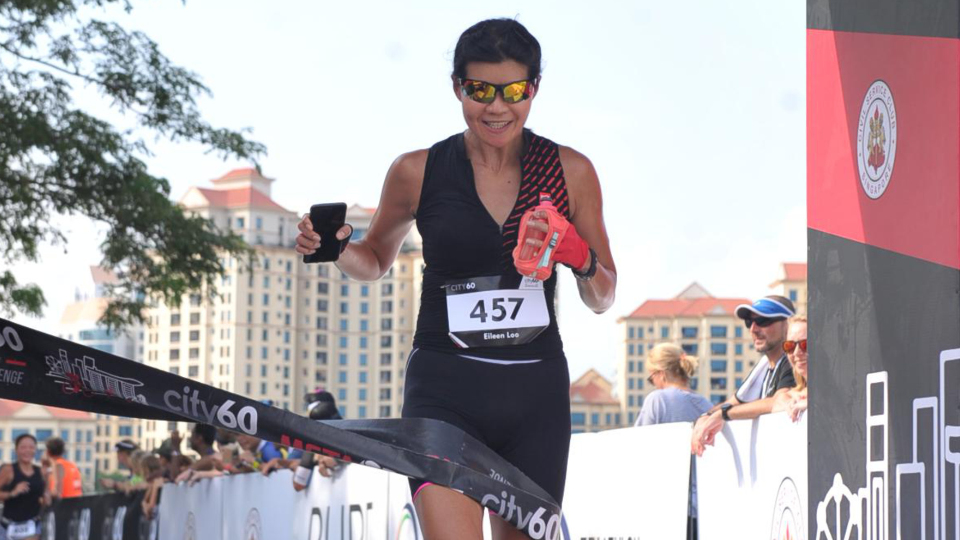
RS: What is your go-to meal or snacks before your Duathlon competition?
Eileen: I consume a lot more fruits, vegetables and grains 2 weeks before a Duathlon race. I used to go to buffets a few days before race day, however, I realised it’s not helping me.
What’s the point of stressing your body with exercise to put in more junk? There’s no need for additional inflammation in the body. The need to repair with plant-based proteins is higher during race month, as my training increase. Hills drills are a killer if you haven’t tried it.
RS: How do you handle your stress and pressure during your Duathlon competition?
Eileen: The only stress and pressure you have are the ones you put on yourself. Trust what you have been training for the last 2-3 months. Your body will perform better when you are mindful and relax.
I pray I don’t get a flat tire or fall off my bike just because I want to overtake someone at the corner. It’s simple. Smile and talk to fellow competitors on race day. It lightens your mood and takes the focus off yourself.
RS: What is the key to becoming a successful Duathlete?
Eileen: Inspire one family or friend and help them to break away their mindset boundaries towards a Duathlon or a multi-sport race. That is a success because it’s now a lifestyle and a change driven by intrinsic motivation as they realised that it’s possible.
It won’t be based on no. of Likes on Instagram/ Facebook. Success also means to do it afraid and complete it. The next 5 am wake-up call is to head out for a cycle or run. You will meet new like-minded friends who will push you to continue racing.
8 years ago, you won’t catch me saying that. Besides the clique of being an inspiration, reckon success is not failing on your promise you make, stick with it and complete it.
You can be successful on your terms. There is a better and faster Duathlon athlete in Singapore/ overseas. Mingle and get to know them post-race or on FB groups.
They are a friendly bunch and can’t wait to pour out their knowledge when you ask. Hey, one more ‘like-minded’ person to join the fun isn’t it?
RS: Are there some useful tips and tricks for beginners who want to do Duathlon?
Eileen: Just sign up afraid. The rest will follow, panic, deep remorse, wake up and get it done, race Day, big smile, repeat ‘crazy’ (Sign up with a friend/family).
You can follow Eileen on Instagram: @simplehealthsg
6. Jelsie De Vera Sabado
Bio: 20 year-old Filipino, Athlete
Jelsie lives in Mangatarem Pangasinan. She has 5 siblings and her hobby is sports. Normally, after training she will spend time with her family and friends.
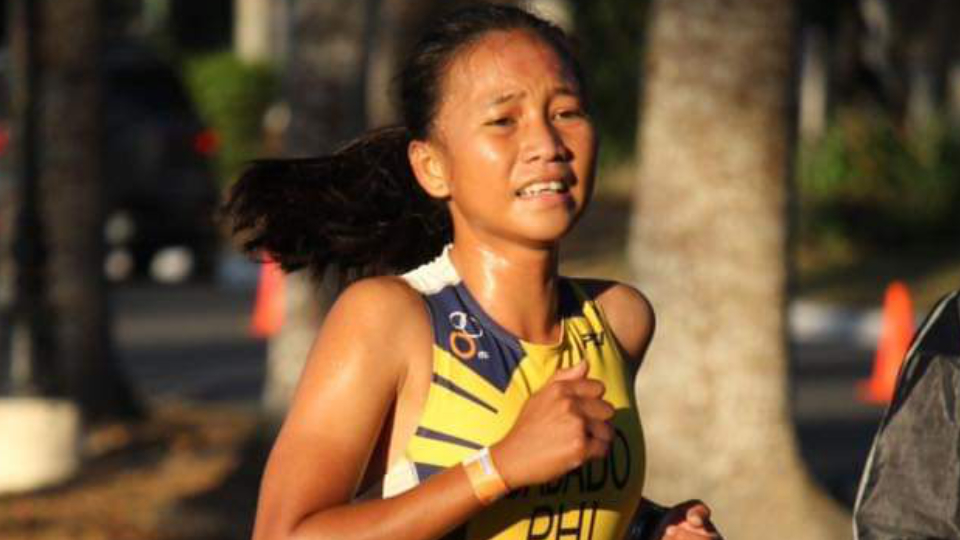
Follow your dreams and do it all trails to your life.
RS: What makes you go for Duathlon?
Jelsie: Someday, I want to be a hero of my country and also encourage other people to try this sport.
RS: How do you avoid injuries during training and competition?
Jelsie: First of all, you need to do stretching before and after the race or training to avoid any injuries.
RS: How do you plan and train for your duathlon?
Jelsie: Example:
- Mon – Work out run and bike run
- Tues – Long run and long bike
- Wed- Work out and run
- Thurs – Long run, long bike and run
- Fri – Work out, run and bike
- Sat – Long bike
- Sun – Long run and swim
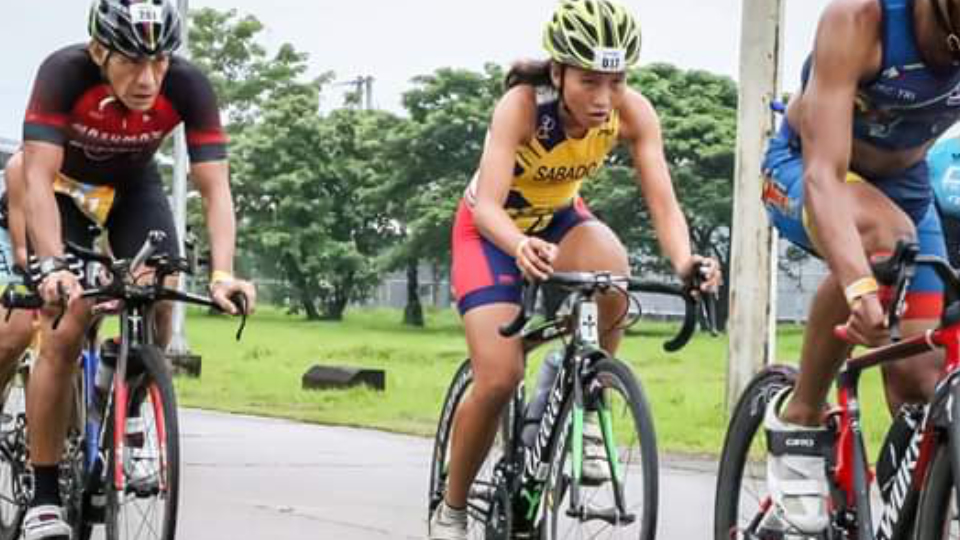
RS: What is your go-to meal or snacks before your Duathlon competition?
Jelsie: Sometimes I drink coffee, bread and banana.
RS: How do you handle your stress and pressure during your Duathlon competition?
Jelsie: Just focus on the race and don’t distract yourself to anything.
RS: What is the key to become a successful Duathlete?
Jelsie: Always train and follow with a coach.
RS: Are there some useful tips and tricks for beginners who want to do Duathlon?
Jelsie: Train hard, don’t give up. Follow your dreams and do it all trails to your life.
You can follow Jelsie on Instagram: @sabadojelsie
Ready to start a Duathlon?
“The miracle isn’t that I finished. The miracle is that I had the courage to start.”
Are you up for a Duathlon race? You will never know you might meet one of the avid duathletes.





